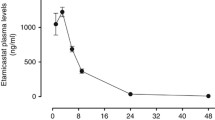Summary
The haemodynamic effect of indenolol, a β-adrenoceptor blocker with intrinsic sympathomimetic activity (ISA) in animals, has been evaluated in a double-blind cross-over randomized trial after acute (3 days) and long-term treatment (28 days), in 12 hypertensive patients in comparison with that of propranolol. Patients were evaluated at rest and during isometric exercise (hand grip). The overall acute effect of both β-adrenoceptor blocking drugs was to decrease mean blood pressure, heart rate and cardiac output, while total peripheral resistance increased. In the long-term studies the haemodynamic effect of propranolol was still characterized by cardiodepression and unchanged peripheral resistance. Patients on the long-term treatment with indenolol showed normal cardiac output and reduced total peripheral resistance.
The data are compatible with a relatively strong ISA of indenolol, which would be responsible for the haemodynamic pattern observed during chronic treatment.
Similar content being viewed by others
References
Man in't Veld AJ, Schalekamp MADH (1983) Effects of 10 different beta-adrenoceptor antagonists on hemodynamics, plasma renin activity and plasma norepinephrine in hypertension. They key role of vascular resistance changes in relation to partial agonist activity. J Cardiovasc Pharmacol 5 [Suppl 1]: 530–540
Takenaka T, Tachikawa S (1972) Beta-adrenergic blocking and cardiovascular properties of a new compound, 1-(7-indenyloxy)-3-isopropylaminopropan-2-ol-hydrochloride (YB-2). Arzneimittelforsch 22: 1864–1869
Tachikawa S, Takenaka T (1973) Pharmacological studies on 1-(7-indenyloxy)-3-isopropylaminopropan-2-ol-hydrochloride (YB-2), a new beta-adrenergic blocking agent. Arch Int Pharmacodyn Ther 202: 79–82
Zuccari G, Falcone A, Turba C (1986) Acute effect of Indenolol on systemic arterial pressure and heart rate in the rat. Pharmacol Res Commun (in press)
Okupa FE, Daneshmend TK, Shrobsbree E, Roberts CJC (1981) Dose-response studies of indenolol, a beta-adrenoceptor blocker. Clin Pharmacol Ther 29: 434–439
Bosisio E, Arosio A, Mandelli V, Sergi M (1980) Ventilatory and pressor response to isometric exercise in normal subjects. Respiration 40: 337–343
Franciosa JA, Ragan DO, Rubenstone SJ (1976) Validation of the CO2 rebreathing method for measuring cardiac output in patients with hypertension or heart failure. J Lab Clin Med 88: 670–672
Ewing DJ, Kerr F, Leggett R, Murray A (1976) Interaction between cardiovascular responses to sustained hand-grip and Valsalva manouvre. Br Heart J 38: 483–490
Sheperd JT, Vanhoutte PM (1979) The human cardiovascular system. Facts and concepts. Chapter 13. Measurement of vascular function and blood volume. Raven Press, New York, p 309
Author information
Authors and Affiliations
Rights and permissions
About this article
Cite this article
Malacco, E., Mailland, F., Bosisio, E. et al. Acute and long-term haemodynamic effects of propranolol and indenolol in hypertension. Eur J Clin Pharmacol 30, 157–160 (1986). https://doi.org/10.1007/BF00614294
Received:
Accepted:
Issue Date:
DOI: https://doi.org/10.1007/BF00614294




